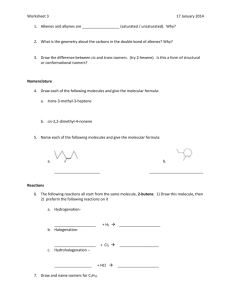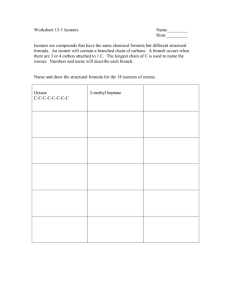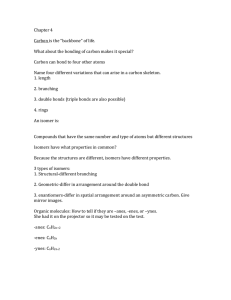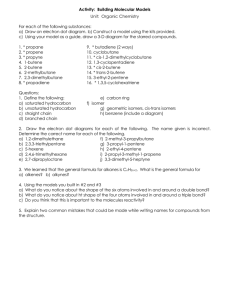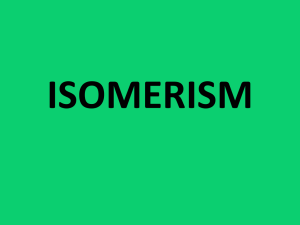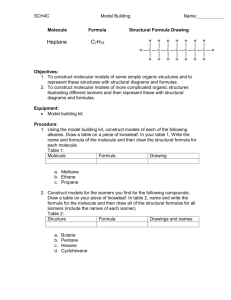Packet
advertisement
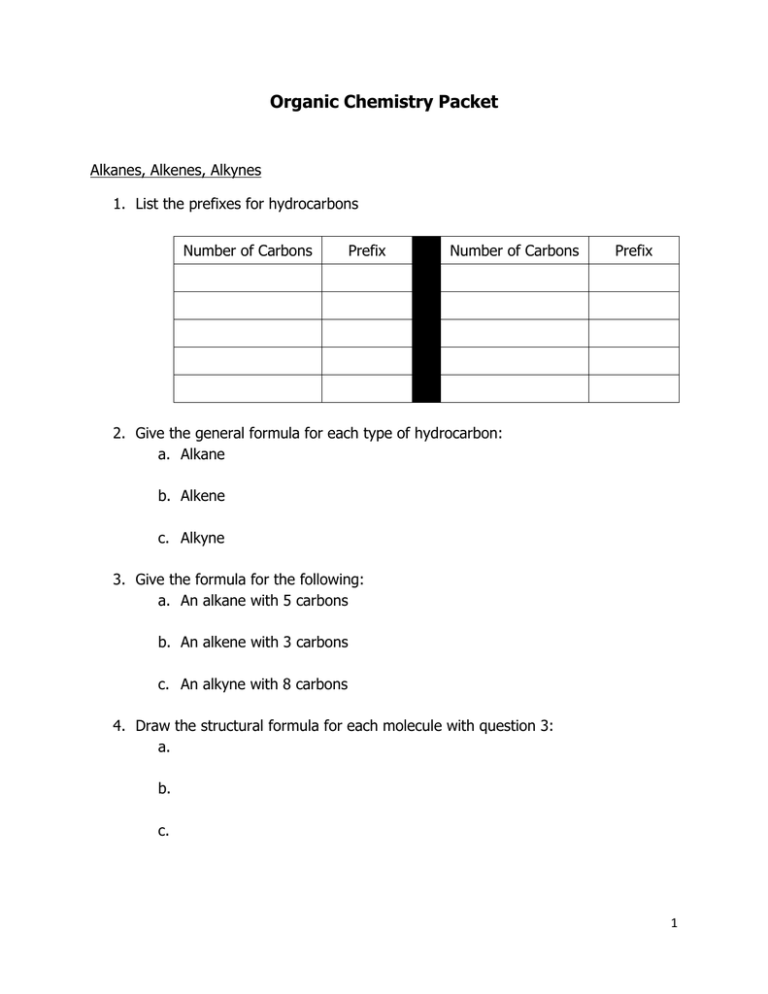
Organic Chemistry Packet Alkanes, Alkenes, Alkynes 1. List the prefixes for hydrocarbons Number of Carbons Prefix Number of Carbons Prefix 2. Give the general formula for each type of hydrocarbon: a. Alkane b. Alkene c. Alkyne 3. Give the formula for the following: a. An alkane with 5 carbons b. An alkene with 3 carbons c. An alkyne with 8 carbons 4. Draw the structural formula for each molecule with question 3: a. b. c. 1 5. Name the following compounds: a. CH3CH=CH2 b. CH3C≡CCH2CH2CH3 c. CH3CH2CH2 CH2CH2 CH2CH2CH3 6. Draw the condensed structural formula and carbon skeleton formula for the following molecules: a. Octane b. Pentene c. Butyne 7. Give the name for each of the following compounds: a. b. c. 2 Alkyl Groups 1. List the alkyl groups for hydrocarbons: Name Condensed Structural Formula Name Condensed Structural Formula 2. Draw the structural formulas for the following compounds: a. 2,2,4-trimethylhexane b. 3-ethyl-2,4,5-trimethyloctane c. 1,1,2-trichlorobutane d. 5-butyl-2,2-dimethylnonane e. 2,2-dimethylpropane 3. Explain why each of the following has an incorrect name. What is the correct name? a. 1,3-dimethylbutane b. 4-methylpentane c. 2,2-diethylbutane d. 2-ethyl-3-methylpentane 3 4. Give the proper name for each skeletal drawing: a. b. c. d. e. f. 4 Isomers 1. For each letter, draw all the iosmers required. a. Draw all the structural isomers of C4H9F. (Hint: 4 isomers) b. Draw all the structural isomers of C7H16 with a carbon chain of 5 atoms. (Hint: 5 isomers) c. Draw all the structural, geometric, and cyclic isomers of C4H8. (Hint: 6 isomers) d. Draw all the structural isomers of C6H3F2Cl that include a benzene ring. (Hint: 6 isomers) 2. In question 1, part a and b, identify all carbon atoms within each isomer that is a chiral center. Denote the carbon atom that is a chiral center with a *. 3. For each organic molecule determine if it is chiral or achiral: a. b. c. achiral achiral achiral 4. Indicate which of the following compounds shows geometric isomerism, draw the structures and specify them as cis or trans. a. 1-butene b. 2-butene c. 1,1-dicholorethene d. 1,2-dicholorethene e. 2-methyl-2-butene f. 1-pentene g. 1-cholorpropene h. 1-chloro-2-methyl-2-butene 5 5. State how the two structures in each of the following pairs are related to each other. They may be structural isomers, enantiomers, diastereomers, or the same compound. 6. Identify each compound in question four as chiral or achiral. a. b. c. d. e. f. g. h. 6 Functional Groups 1. Complete the chart with all the information for each functional group: Functional Group General Formula Structural Formula Naming Suffix Example Drawing Example Name 7 2. For each molecule circle and name the functional group. Some molecules will have more than one functional group; in those cases circle and name all function groups present. 8 3. Draw the structural formula, condensed structural formula and the skeletal formula following molecules: a. 2-methyl-2-butanol b. 2,2,-dimethyl-1-propanol c. 2-penten-1-ol d. 3-butyn-2-ol 4. Name the following organic compounds drawn: a. b. c. d. 5. Using a. b. c. d. the formula C3O2H6, draw the4 following isomers: Draw two isomers that contain an ester. A molecule that contains a carboxylic acid. A molecule that contains two alcohols but no alkenes. A molecule that contains an either and an alcohol. 9 Polymerization 1. Draw the polymer using the monomer. Use 3 monomer units in your polymer. Identify if it is a condensation or addition polymerization. Identify the repeating unit. 2. Write the polymer reaction using styrene; use 3 styrene monomer units in your polymer. Identify where this is a condensation or addition polymerization. 3. Write the polymer reaction when 2 diamines and 2 dicarboxylic acids shown reaction. Is this a condensation or addition polymerization? Identify repeating units. 4. Write the polymer reaction from the reaction of 3 monomer units of the molecule shown. Is this a condensation or addition polymerization? 5. What monomer(s) were used to make each of the following polymers? 10
